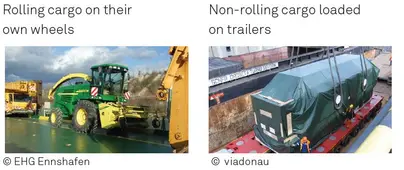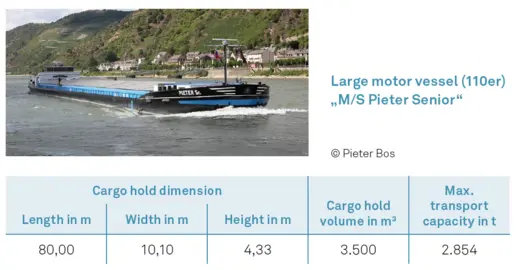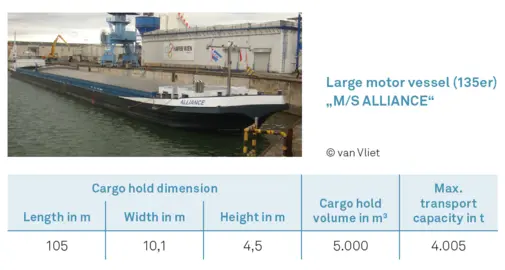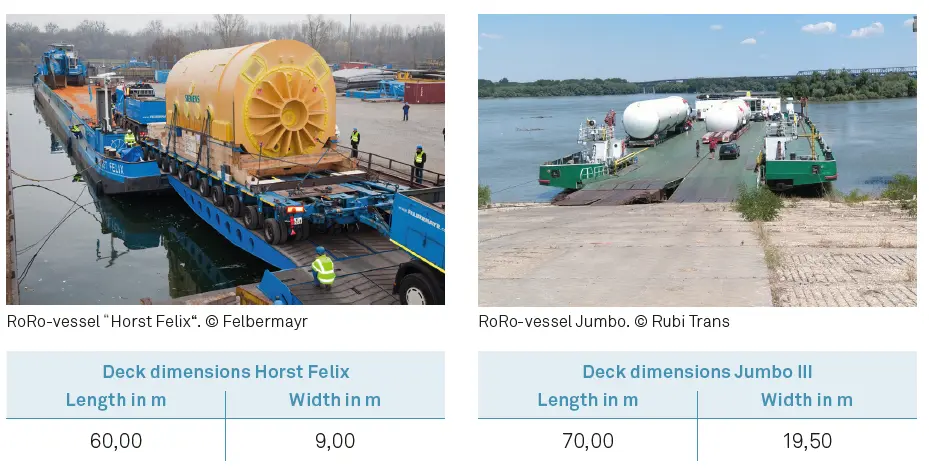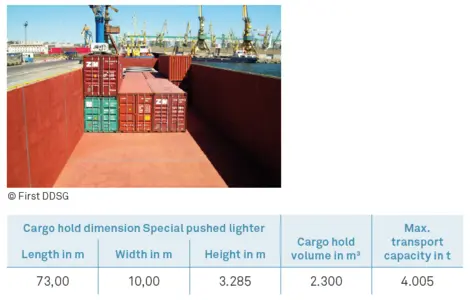Danube shipping is characterized by high loading capacities, low transportation cost and environmental friendliness, which makes it the ideal transport mode for high & heavy cargo. The waterway is often the first choice and not simply an alternative for specialized transports of high-quality products, such as tanks, systems and parts for the energy industry.
From a macroeconomic and eco-political view, inland waterway transportation offers promising opportunities to reduce the production of climate-damaging emissions, such as CO2. In addition, the modal shift towards inland waterway transportation leads to a significant relief for the road infrastructure and thus contributes to increased traffic safety on the road.
Advantages of High & Heavy –Transports on Inland Waterways
High and Heavy cargo can ideally benefit from the advantages associated with Danube shipping due to their large dimensions and heavy loads.
- Inland vessels offer enormous loading capacities with loading spaces of up to 100m in length and 10m in width
- The locks along the Danube work at night and during weekends, enabling a high transportation flexibility
- The usage of the inland waterway is free of charge; the transhipment at ports is subject to payments
- The relatively large bridge clearance heights offer an extensive loading gauge
- High and heavy cargo transports on the inland waterways are usually standard transports and therefore do not require any permits or supervision
- Inland waterway transportation offers numerous ecological advantages over trucks. The emission values per ton are comparatively low
- Dry cargo ships can be multifunctionally used for the transportation of heavy and oversized goods, but also for many other products, thus avoiding empty journeys
Parameters for a High & Heavy-Transport on Inland Waterways
The most important parameters for inland waterway transport planning along the Danube are summarized below. Usually, they determine the use of the correct type of ship, the maximum payload and the maximum possible highest fixed point when passing under bridges:
- Fairway and current fairway depth
- Bridges
-
Availability of the fairway (see Annual Report on Danube Shipping in Austria)
For the regular transport of high & heavy cargo on the inland waterways, which does not constitute a special transport (meaning: the cargo hold of the vessel is sufficient for the transported freight), primarily the current fairway depth must be considered. Typically transports of high & heavy cargo, such as construction machines or generators, are not weight-critical leading to a relatively low draught of the vessel.
Having oversized cargo transports, which stick out of the cargo hold of the inland vessel, bridge clearance levels at critical points must be considered. In some cases, inland vessels carrying oversized goods are ballasted. In this case, the loading depth is increased by loading water into special tanks or by loading solid ballast. This reduces the fixed-point height and enables to drive under bridges securing the required clearance level.
The inland waterway along the Danube is usually available 24/7: The locks along the Danube are working 24 hours a day, seven days a week. In contrast to road haulage, there are no weekend or night driving bans.
Official bans from authorities can be imposed in case of extreme weather conditions, such as floods or during severe ice formations on the Danube. The respective annual analysis can be found in the Annual Report on Danube Navigation in Austria. Ongoing closures and up-to-date notices on the Austrian Danube can be found in the DoRIS Portal.
Ports for the Transhipment of High & Heavy Cargo
In many cases the source and destination of the transport, as well as the locations of the interim storage facility and final assembly, are not situated along the waterway. Therefore, the transhipment of the transported high & heavy cargo is usually necessary.
The following transshipment modes can be distinguished:
- Horizontal transhipment - Roll on/Roll off (RoRo)
- Vertical transhipment - Lift on/Lift off (LoLo)
The transhipment of high & heavy cargo requires special ports infra- and superstructure, such as quay walls and platforms, which can carry high ground pressures for mobile transhipment facilities, heavy cargo cranes or ramps for the loading of rolling cargo.
Along the Danube, numerous ports and terminals offer various options of heavy cargo handling. An up-to-date list including the transhipment starting from 35 tons can be found here.
Detailed information on all ports can be found at the platform Danube Ports.
Inland Vessels for the Transport of High & Heavy Cargo
Dry cargo vessels are used to transport a wide variety of goods, including steel cylinders (coils), agricultural bulk goods, as well as ores and metal goods. These ships are also suitable to transport big, large and oversized break bulk. Due to universal deployment of dry cargo vessels, empty journeys can be reduced to a minimum. The dimensions within the different vessel classes can vary from ship to ship. Summarized below you can find a few examples of dry cargo vessels operating along the Danube.
Special vessels
Roll-on/Roll-off vessel
Roll-on / roll-off transhipment means that the transported objects are loaded (without a crane) either on their own wheels or on trailers/low via ramps belonging to the port or the ship itself. The most important cargo transported via roll-on/roll-off include for example construction machinery and agricultural machines, mobile cranes and other heavy and oversized goods.
Roll-on/Roll-off vessels usually provide a deck offering a broad, continuous loading space for rolling cargo. Dry cargo vessels can be equipped with ramps and partly with modules for several loading decks, which enables the roll-on/roll-off transportation of cars.
Special vessels with reinforced deck
For the transport of particularly heavy break bulk, barges with a reinforced loading deck can be used in order to carry the high loading pressure per sqm. The pushed barge displayed underneath is optimized for the transportation of containers (with a cargo hold of 10,05m width, 4 ISO Containers can be shipped next to each other) and has in addition a reinforced loading deck designed for the transportation of heavy break bulk.
Shipping Companies for High & Heavy-Transports
In contrast to traditional shipments of raw materials, break bulk cargo usually consists of high-quality and unique products, which results in high logistics requirements. Transport delays or even damages on the transported cargo during transhipment must absolutely be prevented.
Not every shipping company is willing to undertake the transport of such cargo. A list of shipping companies and brokers, offering inland waterway transportation of high & heavy and additional services within this field, can be found here.
In addition, the Blue Pages Portal offers a comprehensive list of shipping companies along the Danube.
